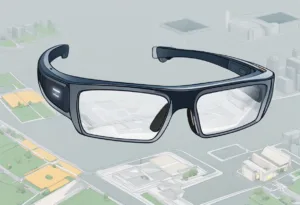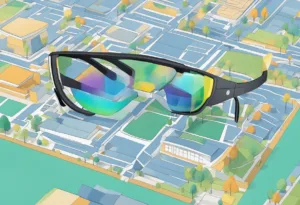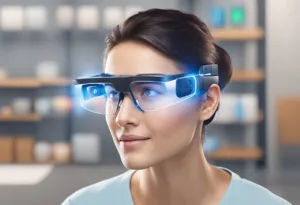AR glasses, also known as augmented reality glasses, are a type of wearable technology that allows users to see digital information overlaid onto the real world. These glasses use a combination of sensors, cameras, and displays to create a virtual layer of information that appears to be part of the physical environment. So how do ar glasses work? In this blog post, we will discuss AR glasses and how they work to provide immersive experience.
Understanding AR technology is crucial to understanding how AR glasses work. Augmented reality is a technology that combines computer-generated images with the real world. It does this by using sensors and cameras to track the user’s movements, and then projecting digital images onto a display in front of their eyes. AR glasses take this technology a step further by integrating it into a wearable device that can be worn like a pair of glasses.
Design and hardware are important components of AR glasses. These glasses typically have a small display that is positioned in front of the user’s eyes, along with cameras and sensors that track the user’s movements. Some AR glasses also include microphones and speakers, which allow users to interact with the digital information they see. The design of AR glasses is still evolving, with new models being developed that are smaller, lighter, and more comfortable to wear.
Key Takeaways
- AR glasses use a combination of sensors, cameras, and displays to create a virtual layer of information that appears to be part of the physical environment.
- Understanding AR technology is crucial to understanding how AR glasses work.
- Design and hardware are important components of AR glasses.
Augmented Reality vs. Virtual Reality
Before diving into the core components of AR glasses, it is important to understand the difference between augmented reality (AR) and virtual reality (VR). While VR immerses the user in a completely digital environment, AR enhances the user’s real-world environment by overlaying digital information onto it. In other words, AR adds a layer of digital data on top of the real world, while VR creates a completely digital world.
Core Components of AR Glasses
AR glasses are made up of several key components that work together to deliver the augmented reality experience. The following are the core components of AR glasses:
- Display System: One of the most fundamental components of AR glasses is the display system. It is responsible for projecting digital images onto the user’s field of view. There are various types of display systems used in AR glasses, including micro OLED displays, waveguide displays, and diffractive waveguide displays.
- Sensors: AR glasses are equipped with a variety of sensors, including accelerometers, gyroscopes, and magnetometers. These sensors help track the user’s head movements, allowing the AR system to adjust the digital overlay in real-time.
- Camera: AR glasses also have a camera that captures the user’s real-world surroundings. The camera sends this information to the AR system, which then overlays digital information onto the camera feed.
- Processor: To process the vast amounts of data required for AR, AR glasses are equipped with powerful processors. These processors are responsible for running the AR software and rendering the digital overlays in real-time.
- Software: Finally, AR glasses rely on sophisticated software to create the digital overlays and track the user’s head movements. The software also determines what information to display and where to display it.
How does AR work?

AR glasses work by overlaying digital information onto the user’s real-world environment. The camera captures the user’s surroundings, and the AR software identifies the objects in the camera feed. The software then overlays digital information onto the camera feed, which is then projected onto the user’s field of view by the display system. The sensors track the user’s head movements, allowing the AR system to adjust the digital overlay in real-time.
AR glasses combine sophisticated hardware and software to create a seamless augmented reality experience. By overlaying digital information onto the real world, AR glasses have the potential to revolutionize the way we interact with our environment.
Design and Hardware for AR Glasses
AR glasses are designed to overlay digital information onto the user’s real-world environment. To achieve this, they require a combination of hardware and software components. The hardware components include lenses, OLED displays, sensors, cameras, waveguides, and projectors, among others.
Optics and Display Technologies
AR glasses use optics and display technologies to project digital information onto the user’s field of view. The lenses in AR glasses are semi-transparent and allow the user to see the real world while also seeing the digital information. The OLED displays in AR glasses are used to display the digital information, and they are positioned in front of the user’s eyes.
Waveguide optics are used to direct the light from the OLED displays to the user’s eyes. These optics are designed to be thin and lightweight, and they use mirrors to reflect the light from the displays into the user’s eyes. This creates the illusion that the digital information is floating in front of the user.
Sensors and Input Methods
AR glasses use sensors and input methods to track the user’s head movements and provide input to the system. The sensors in AR glasses typically include accelerometers and gyroscopes, which are used to track the user’s head movements. This allows the system to adjust the position of the digital information as the user moves their head.
Cameras are also used in AR glasses to capture images of the user’s environment. These images are used to create a virtual map of the user’s surroundings, which is then used to anchor the digital information in the correct position in the user’s field of view.
AR glasses use a combination of hardware and software components to overlay digital information onto the user’s real-world environment. The hardware components include lenses, OLED displays, sensors, cameras, waveguides, and projectors, among others. The software components include algorithms that track the user’s head movements and adjust the position of the digital information accordingly.
AR Glasses Software and User Interface

AR smart glasses require sophisticated software and user interface to deliver an immersive experience. The software is responsible for processing the data from various sensors and providing the user with information. The user interface is the primary means of interacting with the augmented reality environment.
Operating Systems and AR Software
AR smart glasses run on various operating systems, including Android, iOS, and Windows. The operating system provides the foundation for the AR software to run on. The AR software is responsible for processing the data from various sensors, such as cameras, accelerometers, and gyroscopes, to create a virtual representation of the user’s environment.
User-friendly AR software is critical to the success of AR smart glasses. The software must be easy to use and navigate, allowing users to interact with the augmented reality environment effortlessly. The AR software must also be intuitive, providing users with the information they need when they need it.
Interaction and Control
AR smart glasses offer a variety of interaction methods, including gesture recognition, eye-tracking, and voice commands. Gesture recognition allows users to interact with the augmented reality environment by making hand gestures. Eye-tracking technology tracks the user’s eye movements, allowing them to control the device by looking at specific areas on the screen. Voice commands allow users to interact with the device by speaking commands.
The user interface is critical to the success of AR smart glasses. The interface must be intuitive and easy to use, allowing users to control the device effortlessly. The interface must also provide users with the information they need when they need it.
AR smart glasses require sophisticated software and user interface to deliver an immersive experience. The operating system and AR software must be user-friendly, intuitive, and easy to use. The interaction and control methods must be intuitive and provide users with a seamless experience.
Applications of AR Glasses

AR glasses have a wide range of applications across various industries, including education, healthcare, entertainment, and manufacturing. AR glasses have the potential to revolutionize the way people interact with information and the world around them.
Industry and Manufacturing
AR glasses can be used in industry and manufacturing for a variety of purposes, including assembly and maintenance. AR glasses can provide workers with real-time information and instructions, reducing the need for physical manuals and increasing efficiency. AR glasses can also be used to train new employees, providing them with a more immersive and hands-on learning experience.
Education and Training
AR glasses can be used in education and training to provide students with a more engaging and interactive learning experience. AR glasses can be used to display digital content in real-world environments, allowing students to visualize and interact with concepts in new and exciting ways. AR glasses can also be used to provide students with virtual field trips, allowing them to explore new places and cultures without leaving the classroom.
Healthcare and Medicine
AR glasses can be used in healthcare and medicine to provide surgeons with real-time information during procedures. AR glasses can display vital signs, imaging data, and other important information, allowing surgeons to make more informed decisions. AR glasses can also be used to train medical students and residents, providing them with a more realistic and immersive learning experience.
AR glasses have the potential to revolutionize the way people interact with information and the world around them. As the technology continues to advance, the possibilities for AR glasses are endless.
Challenges and Future of AR Glasses

Technical Limitations and Challenges
AR glasses are a relatively new technology that have been facing several technical limitations and challenges. One of the most significant challenges is the limited field of view, which restricts the immersive experience that users can have. The current AR glasses can only display a small portion of the real world, which limits the potential of AR technology.
Another challenge is the fidelity of the display, which includes the resolution and brightness of the display. The resolution of the display must be high enough to provide a clear and realistic image, and the brightness must be sufficient to overcome ambient lighting conditions.
Wireless connectivity is another challenge that AR glasses face. AR glasses require a fast and stable wireless connection to stream data and content from the internet or other devices. The current wireless technologies, such as Wi-Fi and Bluetooth, have limited bandwidth and range, which can cause latency and connectivity issues.
Advancements and Potential
Despite the challenges, AR glasses have the potential to revolutionize the way we interact with the world. Several advancements in AR technology have been made, such as the development of waveguide displays, which can provide a wider field of view and higher resolution. The development of 5G networks can provide faster and more stable wireless connectivity, which can enhance the AR experience.
AR glasses can also provide immersive experiences in various fields, such as entertainment, education, and healthcare. For example, AR glasses can provide interactive and immersive learning experiences that can enhance the learning process. In healthcare, AR glasses can provide surgeons with real-time data and information during surgeries, which can improve the accuracy and safety of the procedure.
AR glasses have several technical limitations and challenges, but they also have the potential to revolutionize the way we interact with the world. With the advancements in AR technology and wireless connectivity, AR glasses can provide immersive experiences and enhance various fields, such as entertainment, education, and healthcare.
Frequently Asked Questions

What components enable AR glasses to overlay digital information onto the real world?
AR glasses rely on a combination of sensors, cameras, and display technologies to overlay digital information onto the real world. The glasses contain a small computer that processes real-time data from the sensors and cameras to create a virtual image that is projected onto the glasses’ lenses. The sensors and cameras track the user’s movements and environment, allowing the virtual image to be accurately positioned and updated as the user moves.
How do AR glasses integrate with gaming experiences?
AR glasses can enhance gaming experiences by overlaying digital elements onto the real world. This can include displaying game elements such as characters and objects within the user’s environment, or creating entirely new virtual environments for the user to explore. The glasses can also track the user’s movements and gestures, allowing for more immersive and interactive gaming experiences.
What are the primary uses of AR glasses beyond gaming?
AR glasses have a wide range of potential uses beyond gaming, including in education, healthcare, and industrial settings. In education, AR glasses can be used to create interactive learning experiences, while in healthcare, they can be used to assist with surgical procedures or provide real-time information to medical professionals. In industrial settings, AR glasses can be used to provide workers with real-time information and instructions, increasing efficiency and safety.
What are the key differences between AR glasses and smart glasses?
While AR glasses and smart glasses share some similarities, such as their use of sensors and cameras, there are some key differences between the two. Smart glasses typically focus on providing the user with information and notifications, while AR glasses are designed to overlay virtual elements onto the real world. AR glasses often have more advanced display technologies, such as waveguides or holographic displays, to create more immersive and realistic virtual images.
Can you list common sensors found in AR glasses and their functions?
Common sensors found in AR glasses include accelerometers, gyroscopes, magnetometers, and depth sensors. Accelerometers measure the glasses’ movement and orientation, while gyroscopes measure the glasses’ angular velocity. Magnetometers measure the glasses’ magnetic field, while depth sensors measure the distance between the glasses and objects in the environment. These sensors work together to provide real-time data on the user’s movements and environment, allowing for accurate positioning and tracking of virtual elements.
What are some potential drawbacks to using AR glasses?
One potential drawback to using AR glasses is their high cost, which can make them inaccessible to many consumers. Some users may experience discomfort or eye strain when wearing AR glasses for extended periods of time. There is also a risk of distraction or disorientation when using AR glasses in certain environments, such as while driving or operating heavy machinery.




